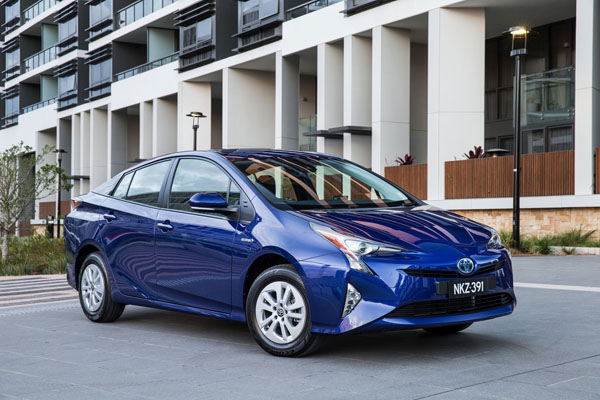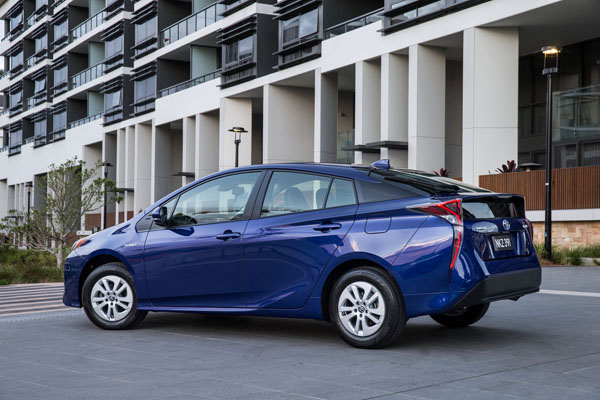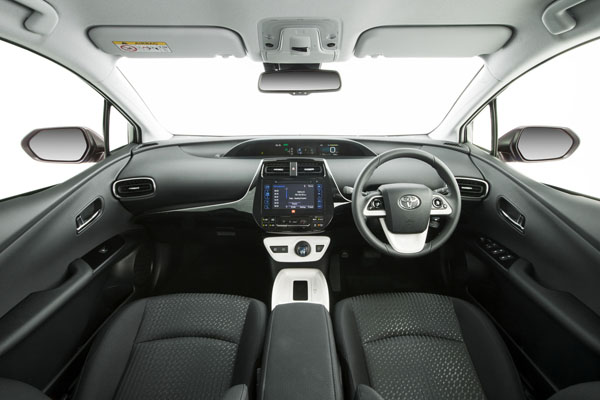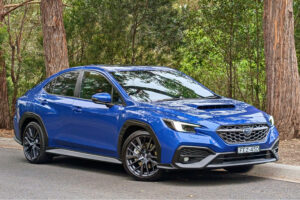
Think what you will about Toyota, when it comes to electric vehicles, the Japanese automotive giant has stuck to its guns. It’s been petrol / electric hybrid all the way.
Its Prius hatchback, in 2001, was the first hybrid to make a real impression on the automobile market in Australia and, indeed, around the world. The ubiquitous Prius taxis speaks to this.
And, it seems, there’s no letting up, with the fourth generation of the pioneering Toyota hybrid, casting off the somewhat frumpy styling of the original model, taking on a sleeker, coupe-like shape, featuring new front and rear treatments, and sharper headlamps and rear lights.
Toyota Australia Vice-President Sales and Marketing Sean Hanley says the Prius hatch has long been the standard-bearer for Toyota’s advanced petrol / electric hybrid technology and this latest styling and technology update would add to its appeal.
“Its [Prius] strength in the marketplace is testament to the proven benefits of the Toyota hybrid system we have rolled out across more models, including Camry and Corolla hatch, and will later this year be offered in RAV4 and Corolla sedan as well,” he adds.
Prius retains its two-model line-up, with the standard version selling for $36,590, plus on-road costs, and the premium i-Tech Prius costing $44,050. The standard model was on test.
STYLING
If imitation is the sincerest form of flattery, Honda should accept it with alacrity as the MY19 Prius is a dead ringer for the Civic hatch, especially around the rear end.
A split window and full-width spoiler, plus new LED lights taking their cue from the shape of the new slimline headlamps, present a more horizontal look emphasising the car’s width and low centre of gravity.
Up front, a revised lower air intake accentuates the sharper, sleeker lines of the car, while a dynamic flowing appearance is further enhanced by a 35 mm increase in overall length.
Unusually, the base Prius rolls on 15-inch alloy wheels with a 10-spoke aerodynamic silver cover, while the Prius i-Tech is more traditional with 17-inch five-spoke alloys in a new titanium-like paint and black finish.
INTERIOR
Inside the cabin is a similar story, with the upgraded Prius featuring new black cloth upholstery, while the i-Tech variant retains its premium leather-accented seats.
The centre console has come in for attention by now incorporating two cupholders, seat heating switches and a wireless phone charger to further improve interior style and ergonomics.
INFOTAINMENT
An advanced seven-inch touchscreen that enables pinch, swipe and flick gestures is part of the latest generation Toyota multimedia system with 10-speaker JBL audio.
The new system features AM / FM / DAB+ radio, USB and Aux inputs, Bluetooth connectivity, satellite navigation with SUNA live traffic alerts, voice recognition and Toyota Link apps including weather, fuel finder and travel times.
Voice recognition now offers a wider range of commands including the ability to set an address while driving and option to search through local points of interest by business name or category.
Other new applications include Siri eyes-free mode for iPhones and Miracast, which can allow compatible smartphone screens to be duplicated onto the touchscreen.
ENGINES / TRANSMISSIONS
The latest generation petrol-electric hybrid drivetrain combines a 1.8-litre 72 kW Atkinson cycle petrol engine with two motor generators to best match performance and fuel efficiency with driving style and road conditions.
A total of 90 kW can be put to ground through a continuously variable transmission
SAFETY
Every present generation Prius is fitted with seven airbags, reversing camera, vehicle stability and traction control, anti-skid brakes, emergency brake signal, hill-start assist and smart entry and start.
The MY19 Prius also showcases a plethora of advanced safety technology thanks to the latest Toyota Safety Sense suite of features that includes active cruise control, pre-collision safety system, lane departure alert to warn of wandering, with steering assist, the latter to nudge the vehicle in the right direction, and auto high beam headlamps.
DRIVING
An all-but silent start-up is announced by the word ‘ready’ on the dash-mounted touchscreen. Move off and the Prius automatically fires up the 1.8-litre petrol engine, putting 90 kW on call, when the electric motor load demands.
The heart of the Prius, however, is the compact high voltage battery which produces better performance while allowing for more luggage space than previously.
Battery life is still an unknown, although, according to a Toyota spokesperson, fewer than one quarter of one per cent have been replaced Down Under. This has encouraged Toyota to increase the battery warranty to eight years / 160,000km from five-year / 100,000km cover on the rest of the vehicle.
Toyota claims combined urban / highway fuel consumption of 3.4 litres per 100 kilometres. With judicious use of the ‘loud’ pedal, I got it down to 2.0 L/100 km at one stage.
The car even congratulated me on my driving economy with a polite message on the touchscreen encouraging me to continue in a like manner. How considerate.
In addition, three driving modes can be dialled up – ECO in which the throttle is reined in for fuel economy; power provides optimum acceleration response, especially useful when overtaking; and EV mode in which the car stays in electric-only for longer at lower speeds – up to 50 km/h for one to two kilometres, depending on the state of charge.
The Prius is comfortable, quiet – there’s just a slight vibration when the petrol engine kicks in – and environmentally clean.
The current generation of Prius was launched in early 2016 as the first model in the Toyota range to feature the company’s new generation architecture platform delivering more agile and responsive driving dynamics and excellent ride comfort. These features have been carried over to the new model.
SUMMING UP
Toyota continues to upgrade its Prius petrol / electric hybrid car but is it enough to keep the model ahead of the rest in the increasingly competitive market of electric vehicles?
AT A GLANCE
MODEL LINE-UP
Prius 1.8 Base: $36,590
Prius 1.8 i-Tech: $44,050
Prius C 1.5 Base: $24,040
Prius C 1.5 i-Tech: $26,540
Note: These prices do not include dealer or government charges. Contact your local Toyota dealer for drive-away prices.
SPECIFICATIONS:
(Prius 1.8-litre four-cylinder petrol / electric hybrid, CVT automatic, 5dr hatch)
Petrol engine:
Capacity: 1798 cc
Configuration: 1.4-litre, 4-cylinder
Maximum Power: 72 kW @ 5200 rpm
Maximum Torque: 142 Nm @ 3600 rpm
Fuel type: Petrol
Hybrid system:
Water cooled DC, permanent magnet
Maximum power: 53 kW
Maximum torque: 163 Nm
Combined system output: 90 kW
Combined Cycle (ADR 81/01): 3.4 litres per 100 km
CO2 emissions 80 g / km
DRIVELINE:
Drivetrain: Continuously variable transmission, front-wheel drive
DIMENSIONS, WEIGHT AND CAPACITIES:
Length: 4540 mm
Width: 1760 mm
Height: 1490 mm
Wheelbase: 2700 mm
Gross vehicle mass: 1775 kg
Fuel Tank Capacity: 43 litres
Turning circle: 10.2 m
BRAKES:
Front: Ventilated disc
Rear: Disc
WARRANTY:
5 years / unlimited kilometres













